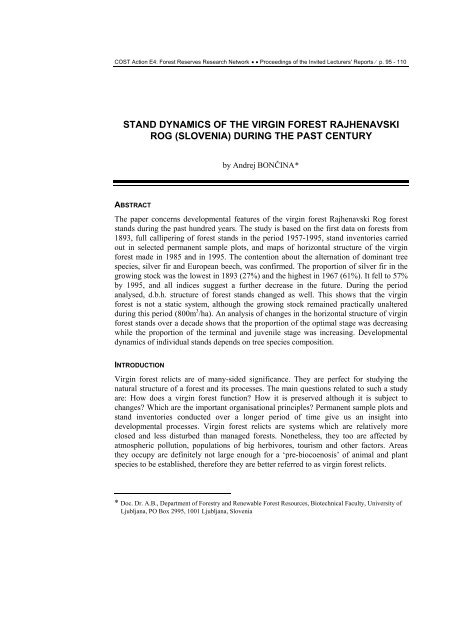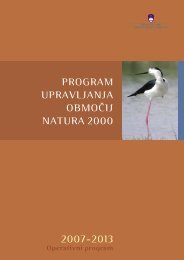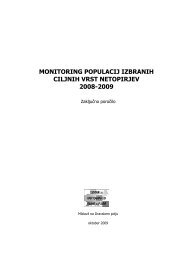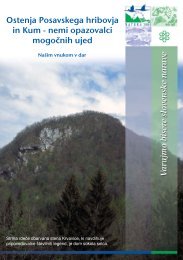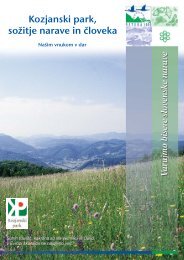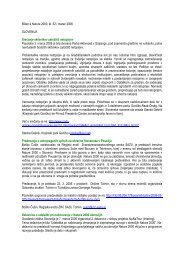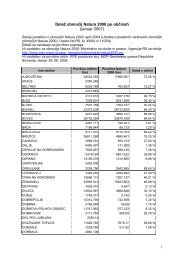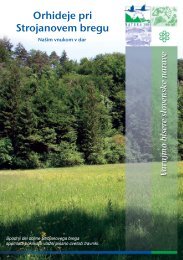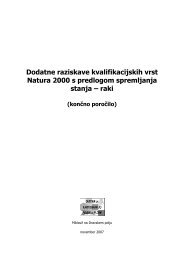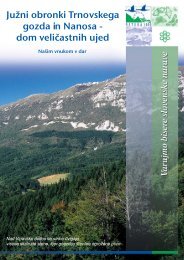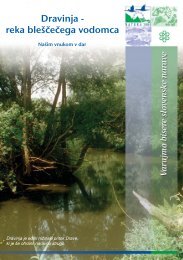VIRGIN FORESTS AND FOREST RESERVES IN ... - Natura 2000
VIRGIN FORESTS AND FOREST RESERVES IN ... - Natura 2000
VIRGIN FORESTS AND FOREST RESERVES IN ... - Natura 2000
You also want an ePaper? Increase the reach of your titles
YUMPU automatically turns print PDFs into web optimized ePapers that Google loves.
COST Action E4: Forest Reserves Research Network • • Proceedings of the Invited Lecturers' Reports ⁄ p. 95 - 110<br />
ST<strong>AND</strong> DYNAMICS OF THE <strong>VIRG<strong>IN</strong></strong> <strong>FOREST</strong> RAJHENAVSKI<br />
ROG (SLOVENIA) DUR<strong>IN</strong>G THE PAST CENTURY<br />
ABSTRACT<br />
by Andrej BONČ<strong>IN</strong>A*<br />
The paper concerns developmental features of the virgin forest Rajhenavski Rog forest<br />
stands during the past hundred years. The study is based on the first data on forests from<br />
1893, full callipering of forest stands in the period 1957-1995, stand inventories carried<br />
out in selected permanent sample plots, and maps of horizontal structure of the virgin<br />
forest made in 1985 and in 1995. The contention about the alternation of dominant tree<br />
species, silver fir and European beech, was confirmed. The proportion of silver fir in the<br />
growing stock was the lowest in 1893 (27%) and the highest in 1967 (61%). It fell to 57%<br />
by 1995, and all indices suggest a further decrease in the future. During the period<br />
analysed, d.b.h. structure of forest stands changed as well. This shows that the virgin<br />
forest is not a static system, although the growing stock remained practically unaltered<br />
during this period (800m 3 /ha). An analysis of changes in the horizontal structure of virgin<br />
forest stands over a decade shows that the proportion of the optimal stage was decreasing<br />
while the proportion of the terminal and juvenile stage was increasing. Developmental<br />
dynamics of individual stands depends on tree species composition.<br />
<strong>IN</strong>TRODUCTION<br />
Virgin forest relicts are of many-sided significance. They are perfect for studying the<br />
natural structure of a forest and its processes. The main questions related to such a study<br />
are: How does a virgin forest function? How it is preserved although it is subject to<br />
changes? Which are the important organisational principles? Permanent sample plots and<br />
stand inventories conducted over a longer period of time give us an insight into<br />
developmental processes. Virgin forest relicts are systems which are relatively more<br />
closed and less disturbed than managed forests. Nonetheless, they too are affected by<br />
atmospheric pollution, populations of big herbivores, tourism and other factors. Areas<br />
they occupy are definitely not large enough for a ‘pre-biocoenosis’ of animal and plant<br />
species to be established, therefore they are better referred to as virgin forest relicts.<br />
* Doc. Dr. A.B., Department of Forestry and Renewable Forest Resources, Biotechnical Faculty, University of<br />
Ljubljana, PO Box 2995, 1001 Ljubljana, Slovenia


